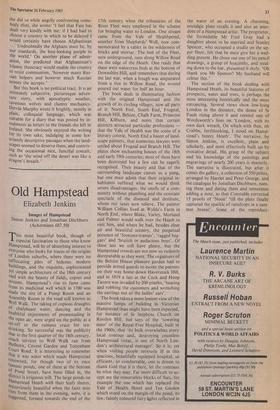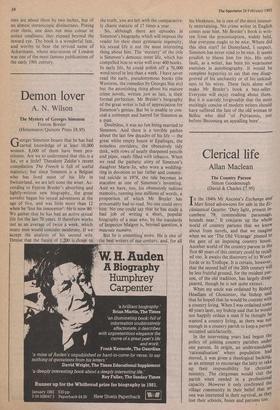Old Hampstead
Elizabeth Jenkins
Images of Hampstead Simon Jenkins and Jonathan Ditchburn (Ackermann £67.50)
This most beautiful book, though of especial fascination to those who know Hampstead, will be of absorbing interest to everyone who looks for traces of the origins of London suburbs, where there were no suffocating piles of hideous modern buildings, and the exquisite, sophisticated Yet simple architecture of the 18th century vied with the beauty of fields, copses and streams. Hampstead's rise to fame came from its medicinal well which in 1700 was Made the site of a Pump Room and an Assembly Room in the road still known as Well Walk. The taking of copious draughts of chalybeate water, dancing and the healthful enjoyments of promenading in the open air, were urged on the public as a set-off to the ruinous craze for tea- drinking. So successful was the publicity that in the first quarter of the 18th century, Coach services to Well Walk ran from Holborn, Covent Garden and Tottenham Court Road. It is interesting to remember that it was water which made Hampstead renowned, for though two of its once famous ponds, one of them at the bottom of Pond Street, have been filled in, the district is irriguous still. The large ponds on Hampstead Heath with their leafy shores, MYsteriously beautiful when the faint mist rises from them in the evening, were, it is suggested, formed towards the end of the
17th century when the tributaries of the River Fleet were employed in the scheme for bringing water to London. One stream came from the Vale of Healthpond, another from Shepherds' Well, now com- memorated by a tablet in the wilderness of bricks and mortar. The bed of the Fleet, now underground, runs along Willow Road on the edge of the Heath. One reads that there were watercress beds at the bottom of Downshire Hill, and remembers that during the last war, when a bough was amputated from a tree in Willow Road, the wound poured out water for half an hour.
The book deals in illuminating fashion with the original Hampstead and the growth of its circling villages, now all parts of it: North End, South End, Frognal, Branch Hill, Belsize, Chalk Farm, Primrose Hill, Kilburn, and notes that certain districts attracted particular professions — that the Vale of Health was the scene of a literary coterie, North End a haunt of land- scape painters, that numerous lawyers were settled about Frognal and Branch Hill.. The plates show enchanting houses of the 18th and early 19th centuries; most of them have been destroyed but a few can be eagerly recognised. Their beauty and that of the surrounding landscape causes us a pang, but one must admit that their original in- habitants suffered what we would think severe disadvantages: the smells of a com- munity without plumbing and the constant spectacle of the diseased and destitute, whom our taxes now relieve. The painter William Collins lived at Wylde's Farm in North pnd, where Blake, Varley, Morland and Palmer would walk over the Heath to visit him, and where he had, besides clear air and beautiful scenery, the perpetual presence of 'footsore-tramps', 'ragged beg- gars' and 'brutish or audacious boys'. Of these last we still have plenty, but the Hampstead crowds are not now so violently disreputable as they were. The organisers of the Belsize House pleasure garden had to provide armed guards to escort the patrons on their way home down Haverstock Hill, and in 1819 a fair at the Cock and Hoop Tavern was invaded by 200 youths, 'beating and robbing the customers and wrenching the earrings out of the ladies' ears'.
The book takes a more lenient view of the massive lumps of building in Victorian Hampstead than might have been expected, for instance of St Stephens Church on Rosslyn Hill, but says of the 'towering mass' of the Royal Free Hospital, built in the 1960s, that 'its bulk overwhelms every local contour and, destroying countless Hampstead vistas, is one of North Lon- don's architectural outrages'. So it is; yet when visiting people seriously ill in this spacious, beautifully equipped hospital, so efficient, so comfortable, one is driven to thank God that it is there, let the contours be what they may. Far more difficult to ac- cept are the remorseless blocks of flats, for example the one which has replaced the Vale of Health Hotel and Tea Garden which stood on the margin of the pond, its few, faintly coloured fairy lights reflected in the water of an evening. A charming, nostalgic plate recalls it and also an anec- dote of a Hampstead artist. The proprietor, the formidable Mr Fred Gray had a daughter about to be married and Stanley Spencer, who occupied a studio on the up- per floor, felt that he must give her a wed- ding present. He chose out one of his pencil drawings, a group of hyacinths, and steal- ing down to the bar, presented it shyly. 'Oh thank you Mr Spencer! My husband will colour this.'
The section of the book dealing with Hampstead Heath, its beautiful features of prospects, water and trees, is perhaps the most interesting historically and the most entrancing. Several views show low-lying London in the distance, the dome of St Pauls rising above it and remind one of Wordsworth's lines on 'London, with its own dark wreath, On which with thee, oh Crabbe, forthlooking, I stood on Hamp- stead's breezy Heath'. The narrative, by Simon Jenkins, is excellent, plain and scholarly, and most effectively built up by evocative detail. His grasp of the subject and his knowledge of the paintings and engravings of nearly 200 years is masterly. The narrative is illustrated, but after it comes the gallery, a collection of 550 prints, arranged by Harriet and Peter George, and the catalogue by Jonathan Ditchburn, nam- ing them and dating them and sometimes adding a note, as that Constable corrected 13 proofs of 'Noon' till the plate finally captured the sparkle of raindrops in a sum- mer breeze'. Some of the reproduct- ions are about three by two inches, but of an almost stereoscopic distinctness. Poring over them, one does not miss colour or notice smallness; they expand beyond the inward eye. The book is a wonderful feat, and worthy to bear the revived name of Ackermann, whose microcosm of London was one of the most famous publications of the early 19th century.











































 Previous page
Previous page